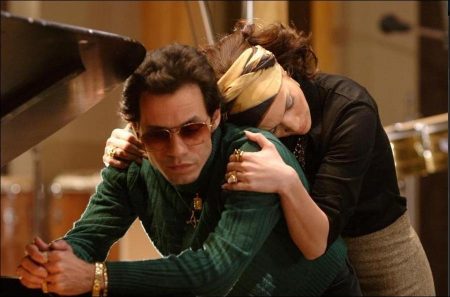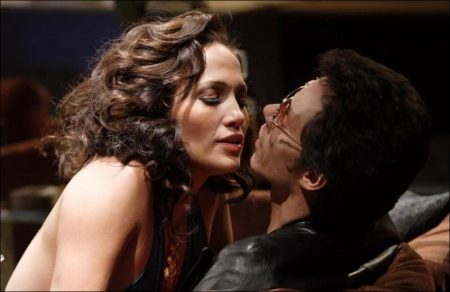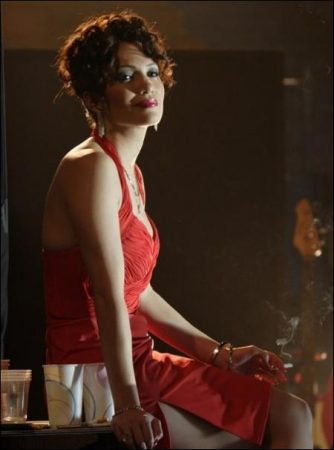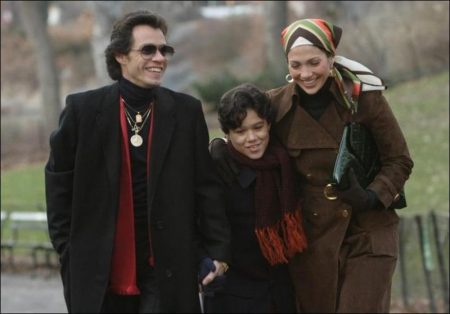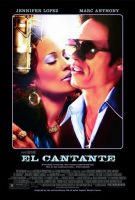Taglines: America discovered him. One woman understood him. But no one could save him from himself…
El Cantante celebrates the life and music of the legendary Puerto Rican salsa singer Héctor Lavoe, a pioneer of the sound and sensibility that redefined Latin music in the 1960s and 1970s. Directed by Leon Ichaso, the film is a labor of love for its stars, Marc Anthony and Jennifer Lopez, who are both New Yorkers of Puerto Rican descent.
Shepherded to the screen and produced by Lopez, El Cantante portrays an era when a new sense of national identity and pride took root in Puerto Rican communities across the U.S. Héctor Lavoe’s music was both a soundtrack to and affirmation of that awakening, and that music courses joyfully through El Cantante.
Spanning the 1960s to the 1980s, El Cantante charts Héctor Lavoe’s rapid rise to success and fame as an artist whose music combined Puerto Rican tradition with streetwise modernity, unabashed emotion with straightforward realism.
It reveals the singer not only as an architect of salsa but as its soul; the kind of artist, like Billie Holliday, Edith Piaf or La Lupe, who forges an uncanny emotional bond with his audience. Love, pain, joy, pride, sorrow, endurance: Héctor Lavoe’s singing contained the raw stuff of life as ordinary people — and he himself — knew it.
As Héctor Lavoe, Anthony mines the contradictory essence of a gifted man who could express anything with his music, but channeled his inner turmoil into a host of self-destructive behaviors. Anthony’s intensity and honesty is matched by that of Lopez, who portrays Héctor Lavoe’s indomitable wife, Puchi. In their first onscreen pairing, the real-life couple captures the complex dynamics of a relationship between two bright, funny and flawed human beings who loved, battled and forgave one another for twenty years, until Héctor Lavoe’s death in 1993.
As a young man in Ponce, Puerto Rico, Héctor (Marc Anthony) is already steeped in music, having grown up with a father (Ismael Miranda) who plays guitar in local orchestras. While his father envisions him joining an orchestra in Ponce, Héctor dreams of a singing career in New York City. But Héctor’s decision to pursue that dream causes a profound rift his father, a rejection that will haunt Héctor in the years to come.
Arriving in New York in 1963, Héctor finds a thriving music scene in the city’s Latino neighborhoods. Energetic, modishly dressed groups of young people crowd the clubs where live bands play rumba, mambo, plena, son, merengue and other types of Latin music. Héctor soon becomes part of that scene as a singer with various bands, and draws the attention of Johnny Pacheco (Nelson Vasquez), a Dominican bandleader and one of Latin music’s biggest stars.
Johnny introduces Héctor to Willie Colon (John Ortiz), an up-and-coming trombonist and bandleader in search of a singer. Together, the two musicians embody the dual nature of New York’s Puerto Rican community: Héctor, the Puerto Rican native who grew up speaking Spanish; and Willie, the New York Puerto Rican, or Nuyorican, who grew up speaking English in the Bronx. Equally important, Héctor and Willie are part of a younger generation that is attuned not only to traditional Puerto Rican styles but also to rock, jazz and R&B. The music they make will be a product of those ingredients, like a sauce: salsa.
As Héctor’s career blossoms, so, too, does his personal life. Smitten virtually upon his arrival in New York by a beautiful, lively club-goer, Puchi (Jennifer Lopez), Héctor turns up uninvited at her birthday party. But the boldness of the gesture stands in contrast to his sweet, polite demeanor and Puchi, who recognizes Héctor from his performances, is intrigued. A sly, teasing flirtation grows deeper as the hours go on, and a romance begins in earnest.
Meanwhile, Héctor is being groomed for stardom. He signs a contract with Fania Records, a new label founded by Johnny Pacheco and Jerry Masucci (Federico Castelluccio) as a Motown for the Latino community and its music. But before Héctor can hit the recording studio as a vocalist with the Willie Colon Orquestra, his last name, the extremely common Perez, will have to go. And so he is rechristened Héctor Lavoe, a play on “la voix,” the French translation of “the voice.”
The singing career that Héctor envisioned as a young man in Ponce is about to materialize. Beginning in 1967, Héctor and Willie release a succession of LPs that are the foundations of salsa, with Héctor’s voice soaring over percolating brass and percussion on records including El Malo (The Bad Guy) and Cosa Nuestra (Our Thing). There are sellout tours, festivals and outdoor events that reflect the heady, psychedelic spirit of the times. Concerts are jubilant extravaganzas that find Héctor in his element, often with Puchi dancing by the side of the stage. In Puerto Rico, throngs turn out to welcome their beloved hero. By the early 1970s, salsa has conquered the streets of New York and cities around the world, and Héctor Lavoe is its voice.
But success is not the uncomplicated boon the young Héctor might have envisioned, and the emotions so easily expressed in music are harder voiced in everyday existence. Héctor’s initial wariness of drugs and alcohol gives way to excess and addiction, and he tests Puchi’s loyalty before and after their marriage with numerous affairs. The mid-1980s will bring more heartbreak: the accidental shooting death of their son, Tito; the death of Héctor’s father and the murder of Puchi’s mother; Héctor’s positive diagnosis for AIDS. But the marriage survives.
Along with music, Puchi is the constant in Héctor’s life. Their relationship is as full of tender, unguarded moments — jokes shared in an empty arena after a concert, a fully clothed Héctor joining his wife in the bathtub — as it is heated arguments.
Throughout good times and bad, Héctor continues to give his all to his music. His fans forgive him his failings, cheer his successes and mourn his tragedies. His voice has become their voice. One night in 1977, the young musician named Ruben Blades (Victor Manuelle) introduces a song he has written specifically for Héctor, performing it once before turning it over to his idol. That song becomes Héctor’s signature, a naked statement of who he is: “El Cantante” (“The Singer”).
About the Production
Throughout their careers, Jennifer Lopez and Marc Anthony have expressed pride in their Puerto Rican heritage, acknowledging its impact on their creative identities as they rose to mainstream stardom. Raised in the Bronx and Manhattan, respectively, Lopez and Anthony have long served as ambassadors for Latin culture in general, and Nuyorican / Puerto Rican culture in particular. It is therefore fitting that their first onscreen collaboration — and the first feature produced by Lopez’s Nuyorican Productions — is the story of a Latin icon, the Puerto Rican salsa singer Héctor Lavoe. An absorbing and entertaining musical biopic, El Cantante is also a heartfelt tribute to a trailblazing talent who became the voice of his people and helped pave the way for future generations of Latin performers — including Lopez and Anthony.
Born Héctor Perez on September 30, 1946, Héctor Lavoe was a country boy from Ponce, Puerto Rico. Like countless islanders before him, he emigrated to the United States to seek his fortune. He was just 17 when he arrived in New York City in May 1963, with dreams of becoming a singer. Four years later, he became an overnight star when he and bandleader/trombonist Willie Colon released their first album together on Fania Records, El Malo (The Bad Guy), a landmark work that would solidify a new style of Latin music, salsa. In its sound, salsa was more hard-driving than its predecessor genres as well as more experimental; lyrically it was different, too, with an urban, gritty and often topical sensibility. Héctor Lavoe sang about the life that people knew in the barrios of America, and he was a master improviser — in salsa terms, a sonero — able to spin dazzling variations on a song’s themes or lyrics. (In a 1997 interview, famed salsa producer, pianist and bandleader Larry Harlow called Héctor Lavoe the “Barrio poet.”)
From the beginning, salsa was an affirmation of identity, in its instrumentation (Hispanic Caribbean mainstays like clave, congas, timbales) as well as its lyrics. The late 1960s and early 1970s saw young Latinos organizing in their communities and demanding a voice in government through political parties like the Puerto Rican Young Lords. The records made by Héctor Lavoe, Colon and other Fania Records artists were a soundtrack for a cultural awakening, and Héctor Lavoe songs like “Mi Gente” (“My People”) and “Paraíso de Dulzura” (“Sweet Paradise”) became enduring anthems of ethnic pride. Meanwhile, salsa had become a global phenomenon, and Héctor Lavoe toured Europe, Latin America and Japan as a solo artist and as a member of his record label’s powerhouse group, the Fania All Stars. In the U.S. and Puerto Rico, there were sold-out shows for thousands of fans at venues including Madison Square Garden and Yankee Stadium.
Between 1967 and 1973, Héctor Lavoe made ten LPs as a singer with Willie Colon and his Orquestra, including the best-selling classics Cosa Nuestra (Our Thing) and Asalto Navideño (Christmas Assault). In 1975, he released his solo debut, La Voz. His 1978 album, Comedia, which introduced his signature song, “El Cantante,” was hailed as a masterpiece, while his final studio album, Héctor Lavoe Strikes Back earned him a Grammy nomination in 1988.
As famous and successful as Héctor Lavoe became, he never lost his essential sense of self, never ceased proclaiming himself — proudly — a jíbaro, a humble Puerto Rican peasant. He was unpretentious and accessible, and could often be found mingling with audience members between concert sets. His struggles with drugs and alcohol were common knowledge, as was the volatile nature of his marriage to his wife, born Nilda Georgina Román and widely known by her nickname, “Puchi.” Héctor Lavoe’s drug habit interfered with his professional life and he was chronically late to concerts; sometimes he didn’t show at all. Yet his fans forgave him, won over by not only his music but also his disarming personality and ironic sense of humor.
When tragedies mounted in his personal life, his fans grieved with him. And when Héctor Lavoe died on June 29, 1993 of complications related to AIDS, the streets were thronged for his funeral procession.
In 2001, eight years after Héctor Lavoe’s death, Jennifer Lopez received a screenplay about the singer’s life. Developed by Héctor Lavoe’s former road manager, David Maldonado, the story by David Darmstaeder and Todd Anthony Bello drew upon several interviews with Héctor Lavoe’s widow, Puchi. It was Puchi’s hope that Lopez would portray her onscreen. “At the time I knew of Héctor Lavoe, but not much about him,” Lopez recalls.
After reading the screenplay, she delved into Héctor Lavoe’s records as well as his biography. “Once I really got to know the music, I realized, ‘This is important.’ Héctor was a voice of the people, a jíbaro, a boy from the sticks. People identified with him.”
By the time Lopez founded her production company, Nuyorican, in 2003, she was determined to bring Héctor Lavoe’s story to the screen. As she puts it, “What better project to be the first movie for Nuyorican Productions? This was a way to thank Héctor, to honor him, for all that he gave and all that he suffered. I wanted everyone to know about this man, this music and this incredible period of time.”
Julio Caro, who worked with Lopez on the 2000 thriller/fantasy The Cell, joined Lopez to produce the film. Caro, who is of Dominican heritage, has been a salsa fan since his youth and knew Héctor Lavoe’s music well. He was eager to make a film that would highlight Héctor Lavoe’s remarkable artistic achievements in the face of a troubled existence.
Comments Caro, “Héctor Lavoe was an immensely talented man who really made all the wrong choices. What made this story worth telling is the legacy he left in music was so redemptive, so uplifting and so powerful that it truly transcended what was a difficult, challenged life, fraught with problems. In a way, his music embodies an optimism that is culturally endemic in the Caribbean Hispanic experience. We don’t have a ‘woe is me’ kind of culture. There are challenges and poverty, but through music there’s an escapism that reaches beyond the notion of ‘I’m going to take a breather from my life.’ It actually becomes culturally relevant. I think Héctor is one of the first folk heroes to come out of popular entertainment in the Latino vernacular, and by virtue of that, he has a very, very central place in Latino folk history.”
Lopez had but one candidate for the part of Héctor Lavoe: salsa superstar Marc Anthony, who re-shaped and revitalized the genre with his 1993 solo debut, Otra Nota. Lopez and Anthony had worked together previously, performing a duet of “Ne Ames” for Lopez’s 1999 debut album, On the 6. Besides being a great singer, Anthony had also established himself as a gifted actor, with credits including the hit independent film Big Night and Paul Simon’s Broadway musical, “The Capeman.” “From the moment I got the script, I said, ‘Nobody can play this but Marc Anthony,’” Lopez reports. “I called Marc and told him I was doing this project, and he said, ‘Héctor Lavoe, he’s my idol.’”
To Anthony, it’s difficult to overestimate Héctor Lavoe’s importance as a musical artist and cultural beacon. “He was our Bob Dylan,” says the singer/actor. “He spoke the language of the people. He wasn’t refined, was from the streets. He understood what it was like to be Puerto Rican in this country, to be lucky yet destructive at the same time.”
As it happened, Anthony had his own memories of the singer — and his playful personality. Early in his career, Anthony worked with New York producer and bandleader Little Louie Vega, who was Héctor Lavoe’s nephew. One day, Vega took Anthony — then a teenager with long hair — to meet his hero. Anthony describes the scene at the apartment, where Héctor Lavoe was watching TV in the living room. “Louie introduced me and Héctor said hello without looking away from the set. I sat down next to him on the couch and we watched TV together for a while. Finally he looked over at me, gasped, and said in Spanish, ‘My god, that’s the ugliest woman I’ve ever seen!’” Anthony laughs. “That was my introduction to the famous Héctor Lavoe sense of humor.”
To direct the project, Lopez, Caro and their fellow producer, Simon Fields, tapped awardwinning Cuban-born filmmaker Leon Ichaso, who has explored the Latino experience in films including El Super, Bitter Sugar, and the biopic Pi-Ero. Ichaso was a longtime salsa fan, having followed the music since moving to New York in 1967, the year “El Malo” was released.
He began his film career directing Spanish-language television commercials, recording the ads’ jingles with salsa musicians including Yomo Toro, who recorded with Héctor Lavoe and is a master of the Puerto Rican guitar, the cuatro. Ichaso went on to direct a film about salsa, 1985’s acclaimed Crossover Dreams, which he wrote specifically for its star, singer/composer Ruben Blades – who wrote the song “El Cantante” for Héctor Lavoe.
In re-working the film’s screenplay for El Cantante, Ichaso was able to draw on his familiarity with salsa’s evolution and flowering. He notes that the music took shape amid the creative ferment and changing dynamics of the mid-60s, as popular music became more overtly political; opposition to the Vietnam War mounted; and the civil rights movement grew to encompass different minorities who began organizing and demanding changes to the status quo.
“Salsa was an answer to the times, parallel to what was happening in the rest of the culture,” comments Ichaso. “These young salsa musicians understood the sense of change and rebellion that the 60s ushered in, which touched on ethnicity and welcomed everyone to join in. These guys said, we can do our thing, with our own roots. They were using the mambo and the rumba and the cha-cha, the plena, and the old stuff — but they were giving it a new kick, making it jazzier, introducing new elements. They were playing on the streets of the Lower East Side, experimenting as much as the rock & roll acts playing a few blocks down the street at the Fillmore East.”
He continues, “These young guys were keeping a culture alive, even though some of them never been to Puerto Rico. It was fascinating how some people just retained that heritage — or discovered it, in some cases. When Willie Colon met Héctor Lavoe, he hardly spoke Spanish. But Héctor brought the island with him: he oozed Puerto Rico.”
Héctor Lavoe’s music is threaded throughout El Cantante, and includes both collaborations by Colon and Héctor Lavoe, and songs written entirely by Héctor Lavoe. Ichaso found nuances in the songs he had missed the first time around. Says the filmmaker, “It was a rediscovery for me. Until I got into this project, I had never noticed the poetry, the use of images in those songs. They were prophetic, some of them. Héctor sang about his life, his death, his lucky day. So in the film, the songs became little chapters about Héctor’s life.”
El Cantante sets Héctor Lavoe’s life against a vivid backdrop of his times: the hopeful 1960s, the hedonistic 1970s and the increasingly dark 1980s. It views his rise and fall through the prism of his relationship with Puchi. Héctor Lavoe’s widow passed away in 2002, before Lopez could meet her. However, the actress/producer was able to obtain CDs of the interviews Puchi gave about Héctor and spent hours reviewing them.
“I believe Puchi had a very hard life and lived with a lot of pain. But she was very strong; she was one of those people that says what she thinks and is not afraid to fight,” Lopez comments. “I talked to people who said, ‘I hated Puchi, she was horrible. If it wasn’t for her, he might have gotten clean.’ And I’d say, ‘But if it wasn’t for her, he might not have lived more than five years with his drug habit.’ She was the one who was always pulling him out of those shooting galleries, giving him something to come back to. I’m not saying they were good for each other — I don’t think they were. He was insanely jealous, she was insanely jealous; they were enabling each other with the drugs. Héctor and Puchi loved each other to death — but I do believe they loved each other.”
Lopez relished the opportunity to explore this complex and at times unsympathetic character. “Puchi was the most challenging part I’ve ever played, and I don’t think I could have done it before this time in my life,” she reflects. “Five, ten years ago, I wasn’t ready to play a part like this. You have to be so free, so confident and ready to live in that moment; I wasn’t there as an actress yet. I had to be the character that says, ‘I don’t care if they like me or not. I love Héctor, I’m going to save Héctor, I’m here for Héctor. And that’s it.’ I couldn’t worry about whether people were gonna love Puchi or not. It wasn’t about that. It was about telling the honest story.”
In preparing for the role of Héctor Lavoe, Anthony pored over interviews and studied Héctor Lavoe’s LPs and filmed performances. “I understood him as a musician first, and what his drive was,” Anthony explains. “Then in analyzing his music and the material that he chose and what he chose to sing about, I saw that he was reaching out in a very unique way. When a lot of musicians were singing about how great life was and dancing all night, Héctor was talking about how painful life can be.”
Anthony notes that Héctor Lavoe’s introduction to drugs came in the 1960s, when usage became far more commonplace and drugs like LSD were seen as creative tools by many types of artists. “Drugs were part of the times,” he reflects. “It was the period of free love, free everything. No one saw anything bad with it, but Héctor had a very addictive personality. And many reasons to want to escape.”
Production on El Cantante began on December 5, 2005, and took place over the course of 33 days in New York City and Puerto Rico, wrapping the first week of February 2006. Ichaso praises Anthony and Lopez for their intense commitment to their roles.
“Most people know Marc as a singer, and some have seen him in films — but people won’t be ready for this. When you see him onstage, at times it’s like there’s just one person: Marc becomes Héctor, Héctor becomes Marc. Everything is in his eyes — the joy, the drama. Also, like Héctor, Marc has incredible comedic timing. He’s a natural.”
He describes Lopez’s performance as “fearless. She is rougher, more vulgar and raw, than any Jennifer we’ve seen before. Puchi is defiant. She smokes, she does blow. There was nothing that would stop Jennifer from being this character in every way: the way she dressed, the way she behaved, the interplay with Héctor. All of that was very, very difficult and yet she did it with precision. A lot of actors, actresses, singers might have some vanity. But she shed the vanity to make sure she was playing Puchi as she really was.”
Anthony re-recorded Héctor Lavoe’s songs for the film, accompanied by professional musicians who included former members of the Héctor Lavoe Orquestra and the Willie Colon Orquestra. The Madison Square Garden concert sequences were filmed in Puerto Rico, an occasion that served as a potent reminder of how strongly audiences identified with Héctor Lavoe. The public had been invited to serve as extras, and the filmmakers were prepared to shoot quickly.
“Audiences usually get itchy — they’re hungry, they want to go to the bathroom, and so on,” explains Ichaso. “Well, these people came dressed in period clothing. They came with Héctor Lavoe’s banners. And flags, and T-shirts: the works. They were so happy; some of them were in tears. Then, without being cued, they started chanting: ‘Héctor! Héctor! Héctor!’ And it grew, and then the chanting became, ‘I am Puerto Rican and don’t you forget it! I am Puerto Rican, and don’t you ever forget it!’ We were like, ‘Wow.’ For sure, this was a powerful movement.”
Many of Héctor Lavoe’s friends and colleagues participated in the filming, including three members of the Fania All Stars: singer Ismael Miranda, who plays Héctor Lavoe’s father; cuatro player Yomo Toro; and congo virtuoso Eddie Montalvo. Izzy Zanabria, a graphic artist who coined the term “salsa” and published the music magazine Latin NY, appears as a concert emcee. Says Ichaso, “A lot of people came to the table. They were part of salsa then, and they’re part of this film now. Everybody came to take their hats off to Héctor.”
“It was an honor to play Héctor Lavoe,” affirms Marc Anthony. “To me, he was almost a sacrificial lamb, that one guy who would represent and be loved by legions of fans but lived the most painful life imaginable. That’s just what he was born to be.”
Hector Lavoe Discography
As Singer with Willie Colon Orquestra
• El Malo (The Bad Guy) (1967)
• The Hustler (1968)
• Guisanda – Doing a Job (1968)
• Cosa Nuestra (1969)
• La Gran Fuga (The Big Break) (1970)
• Alsato Navideño (1971)
• El Juicio (1972)
• Alsato Navideño Vol. 2 (1972)
• Lo Mato (Si No Compra Este LP) (1973)
• Willie (1974)
As Solo Artist (including posthumous releases)
• La Voz (1975)
• De Ti Depende – It’s Up to You (1976)
• Comedia (1978)
• Feliz Navidad (with Daniel Santos and Yomo Toro) (1979)
• Homenaje a Felipe Pirela (1979)
• El Sabio (1980)
• Que Sentimiento (1981)
• Revento (1985)
• Strikes Back (1987)
• The Master and the Protégé with Van Lester (1993)
• Live! (1997)
• Tu Bien Lo Sabes (2001, with never-before-released title song, recorded 1981)
• Mi Regreso: Héctor Lavoe Live at Club Borinquen (2006)
As Guest or Collaborator
• The Good, the Bad, the Ugly (with Willie Colon and Yomo Toro, 1975)
• Déjà Vu (Willie Colon, 1978)
• Vigilante (Willie Colon, 1983)
With The Fania All-Stars
• Live at the Red Garter Vol. 1 (1968)
• Live at the Red Garter Vol.2 (1969) song: “Noche” with Pete “El Conde” Rodríguez, Ismael Miranda and Adalberto Santiago
• Live At The Cheetah Vol. 1 (1972) song: “Quítate Tu” with: Adalberto Santiago, Ismael Miranda, Pete “El Conde” Rodríguez, Santos Colon and Johnny Pacheco
• Live At The Cheetah Vol. 2 (1972) song: “Que Barbaridad” with Ismael Miranda
• Fania All Stars: Our Latin Thing (soundtrack, 1972) song: “Quítate Tu” with Adalberto Santiago, Ismael Miranda, Pete “El Conde” Rodríguez, Santos Colon and Johnny Pacheco
• Fania All Stars Live at Yankee Stadium Vol. 1 (1975) song: “Mi Gente”
• Fania All Stars Live at Yankee Stadium Vol. 2 (1975) song: “Congo Bongo” with Cheo Feliciano
• Salsa, Original Motion Picture Sound Track Recording (1976) song: “Mi Gente” recorded live at the inauguration concert of Roberto Clemente Coliseum, San Juan Puerto Rico 1974
• Tribute To Tito Rodríguez (1976) songs: “Cuando, Cuando, Cuando” and “Vuela La Paloma” with Santos Colon, Ismael Quintana, Ismael Miranda, Justo Betancourt, Bobby Cruz, Pete “El Conde” Rodríguez and Cheo Feliciano
• Fania All Stars Live (1978) song: “Saca Tu Mujer” with Ismael Quintana, Santos Colon, Ismael Miranda, Cheo Feliciano, Celia Cruz and Justo Betancourt
• Habana Jam (1979) song: “Mi Gente / Barbarazo” with Wilfrido Vargas
• Commitment (1980) song: “Ublabadu”
• Latin Connection (1981) song: “Semilla de Amor”
• Lo Que Pide La Gente (1984) songs: “El Rey De La Puntualidad”, “Por Eso Yo Canto Salsa” and “Usando El Coco” with Cali Aleman, Ismael Quintana, Ismael Miranda, Adalberto Santiago, Pete “El Conde” Rodríguez and Celia Cruz.
• Viva La Charanga (1986) songs: “Me Voy Pa’ Morón”, “Isla Del Encanto” & “Guajira Con Tumbao” with Ismael Miranda, Pete “El Conde” Rodríguez and Cali Aleman
• Bamboleo (1988) song: “Siento”.
With Tito Puente
• Homenaje a Beny Moré Vol. 2 (1979) song: “Donde Estabas Tu”
• Homenaje a Beny Moré Vol. 3 (1985) song: “Tumba Tumbador”
El Cantante (2007)
Directed by: Leon Ichaso
Starring: Jennifer Lopez, Marc Anthony, Federico Castelluccio, Romi Dias, Denise Blasor, Romi Dias, Glenda Dopazo, Romi Dias, Tito Allen, Christopher Becerra, Ismael Miranda
Screenplay by: Todd Antony Bello, David Darmsteder, Leon Ichaso
Production Design by: Sharon Lomofsky
Cinematography by: Claudio Chea
Film Editing by: David Tedeschi
Costume Design by: Sandra Hernandez
Set Decoration by: Jennifer Greenberg
Art Direction by: Nicholas Lundy
Music by: Willie Colón, Andrés Levin
MPAA Rating: R for drug use, pervasive language, sexuality.
Distributed by: Picturehouse
Release Date: August 3, 2007
Visits: 88
